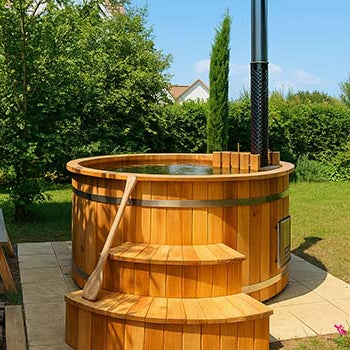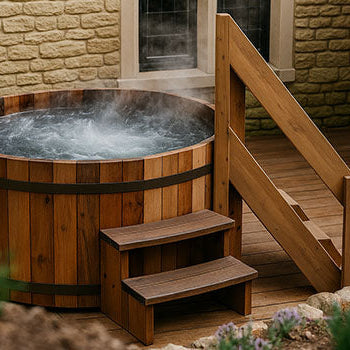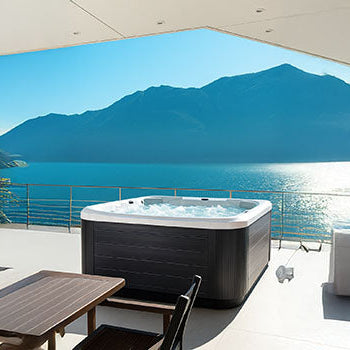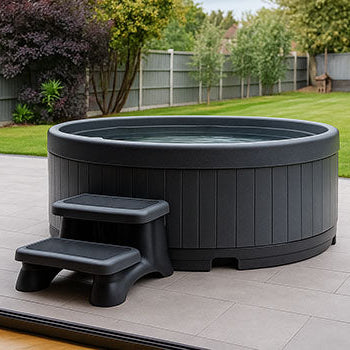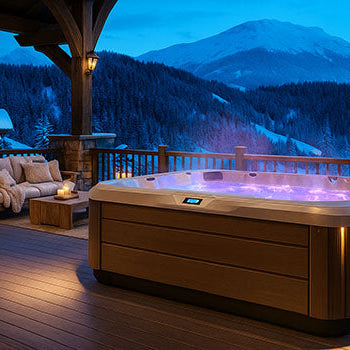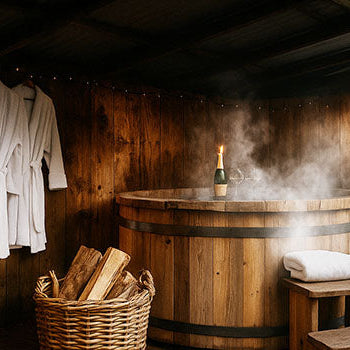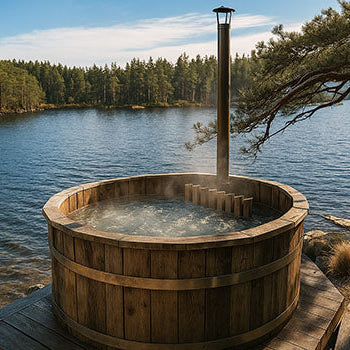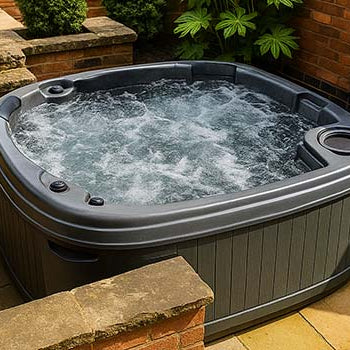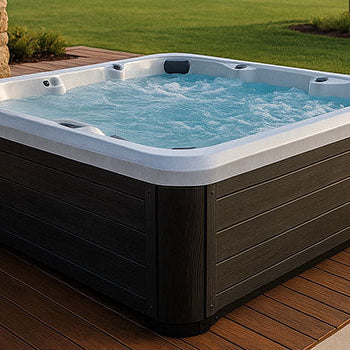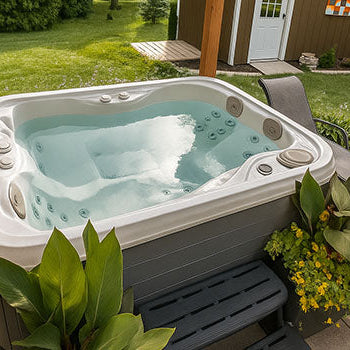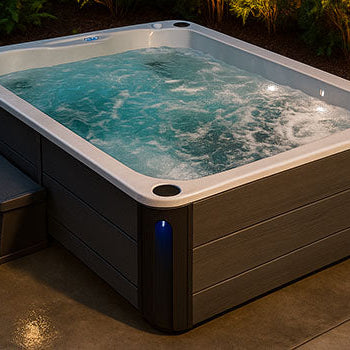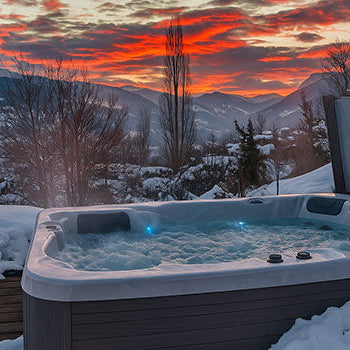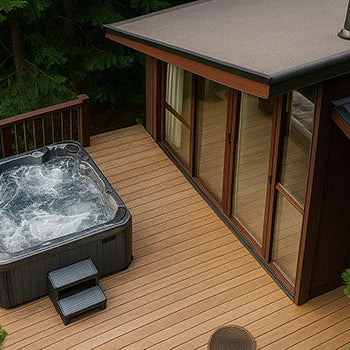Ever stood by your hot tub, hose in hand, thinking, “Can I just let this flow into the garden?” You’re not alone. It feels like a good idea, especially on a hot day with thirsty plants and no rain in sight. Short answer? Yes, but only if you do it properly. The water inside your Acrylic Hot Tub or trusty old Rotomoulded spa isn’t just warm, it’s chemically dressed for a pool party. Wooden Hot Tubs too, no matter how rustic, hold water that can stress out your soil if you’re not careful. So before you turn your garden into a mini spa, here’s what you really need to know.

Why Draining Hot Tub Water Needs Careful Consideration
Identifying the Chemicals in Used Hot Tub Water
Hot tub water may look clean, but under the surface it’s a chemical cocktail. You’ll usually find chlorine or bromine, pH modifiers, anti-foam agents, and scale removers floating around. These keep your tub hygienic, but your hydrangeas won’t appreciate the spa treatment.
Potential Harm to Lawn, Plants, and Soil Life
Dumping chemically treated water straight onto your lawn can do more harm than good. Grass can burn, flower beds may wilt, and soil microbes (your garden’s unsung heroes) can be wiped out. Even hardy shrubs might show stress if the water’s pH is off.
Risks to Local Wildlife, Ponds, and Waterways
If your garden backs onto a stream or has a fishpond, take extra care. Even a trace of chlorine can harm frogs, birds, and aquatic life. Pets lapping up puddles could also get sick. Garden runoff doesn’t always stay put, it flows, and so do the risks.
Understanding the Key Chemicals: Chlorine and Bromine
How Quickly Chlorine Breaks Down
Chlorine is the easier guest to kick out. If you stop adding it and leave the tub uncovered, it usually fades within 2–3 days thanks to sunlight and air exposure. But until then, that water should be going nowhere near your dahlias.
Bromine's Longevity in Water
Bromine likes to hang around. It stays active longer than chlorine, especially in cool or shaded tubs. That means extra patience is needed before it’s safe to drain, testing is a must, not a guess.
Impact of pH Balancers and Other Treatment Products
It’s not just sanitisers that pose a risk. pH balancers can skew your soil chemistry, while anti-foam agents may clog plant roots. The water might look fine, but chemically speaking, it still packs a punch.
Is Garden Draining Safe? Key Factors for UK Homeowners
Sanitiser Levels Remaining in the Water
This is your first checkpoint. You need chlorine or bromine levels below 1 ppm, ideally zero, before draining. Anything higher, and you risk scorching your lawn or worse. Always test, don’t eyeball it.
Sensitivity of Your Garden Plants and Soil Type
Your soil might be clay-heavy, sandy, or somewhere in between, and it matters. Sandy soil drains fast, but chemicals might pass through too quickly to neutralise. Delicate plants like ferns or orchids can suffer damage, while tougher ones like rosemary or lavender may hold their own.
Size of Garden vs. Volume of Water
If you’ve got a small garden and a large spa, you need a plan. A 1,500-litre drain on a postage stamp lawn? Disaster. The ground can flood, roots drown, and soil compacts. Always consider space and capacity before you release the floodgates.
Proximity to Drains, Watercourses, and Neighbouring Land
Water finds the easiest path, and that might be into your neighbour’s barbecue area. Avoid draining near fences, pavements, and natural water sources. What seems like a private garden job can quickly become a neighbourhood issue.

How to Make Hot Tub Water Safer for Potential Garden Discharge
Allow Sanitiser Levels to Drop Naturally (Stop Dosing, Remove Cover)
Planning ahead is your best tool. Stop adding chemicals 3–4 days before draining, and take off the lid to let sunlight help break them down. A gentle stir now and then can speed up the process.
Test Water to Confirm Low/Zero Sanitiser Levels Before Draining
Use spa test strips, readily available and easy to use. Aim for near-zero chlorine or bromine before you even think about using that hose. Don’t take chances on a hunch, chemicals don’t work that way.
Consider Using a Specific Dechlorinator/Neutraliser Product
Pressed for time or just impatient? Dechlorinators (or bromine neutralisers) are available at most spa stores, and they work fast. Just make sure to follow the instructions, they’re powerful, and using too much can do more harm than good.
Let the Water Cool to Ambient Temperature
Plants don’t love hot tubs like we do. Let the water cool to 20°C or lower before draining. Hot water can cook plant roots, especially on warm days, so play it safe and let it cool off.
Best Practice for Draining Your Hot Tub in the UK
The Preferred Method: Draining to a Foul Water Sewer
This is the gold standard. If you can, connect your hose to a foul water drain (like a bathroom or utility drain). The water then goes to a treatment facility instead of your garden beds.
Using a Pump and Hose for Controlled Discharge
A submersible pump and garden hose let you drain slowly and with direction. You control where the water goes, avoiding plant beds and high-traffic garden areas. No one wants soggy shoes from an accidental flood.
Why Avoiding Storm Drains is Crucial
Storm drains lead straight to rivers and streams, no filters, no treatment, just straight-through flow. Dumping spa water here isn’t just harmful, it’s often illegal. Stick to proper drainage systems or the garden with care.
If Garden Discharge is Unavoidable: Drain Slowly and Widely
If you must use the garden, spread it out. Let the water trickle over different areas, not all at once. Move the hose every few minutes. Hardy lawn patches are ideal, avoid anything delicate or freshly planted.
UK Regulations and Environmental Responsibility
Environment Agency Guidance on Discharges
In the UK, the Environment Agency treats chemically treated water as controlled waste. That means you’re responsible for where it ends up. Discharge it improperly, and you could face enforcement.
Local Council Bylaws and Considerations
Councils vary in their rules. Some may allow garden draining if the water is treated and neutralised, but others are stricter. Before you drain, it’s worth giving them a call or checking your local authority’s website.
Adopting Environmentally Conscious Practices
Want to make life easier? Reduce your chemical use year-round, reuse water when possible, and stay informed. Responsible hot tub care protects not just your garden, but your neighbours, your pets, and the planet too.

Conclusion: Prioritise Sewer Draining; Exercise Caution with Garden Discharge
It might feel like just a quick job, but draining a hot tub is something you want to do right. The best choice is always draining to a foul water sewer. If you can’t, the garden can work, but only if the water is cool, chemical-free, and spread with care.
Think of your garden as a guest, not a dumping ground. Take a few minutes to test, wait, and plan, and your lawn will thank you. Your plants will stay healthy, the wildlife will stay safe, and your conscience will stay clean. Win-win-win.
